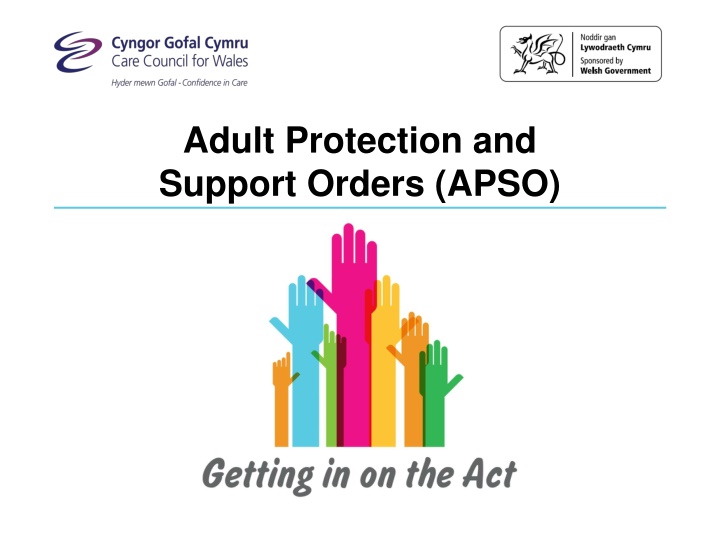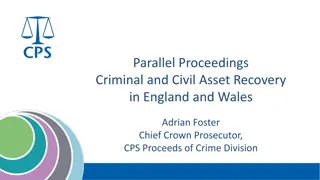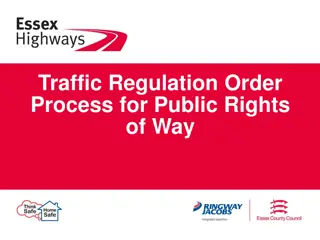Adult Protection and Support Orders (APSO) in Wales
This session aims to empower authorized and legal officers to use APSOs in compliance with the law and the Act's principles for the benefit of adults at risk in Wales. It covers the legal framework, ethical considerations, the purpose of APSOs, decision-making responsibilities, and promoting well-being while respecting human rights and individual autonomy.
Download Presentation

Please find below an Image/Link to download the presentation.
The content on the website is provided AS IS for your information and personal use only. It may not be sold, licensed, or shared on other websites without obtaining consent from the author.If you encounter any issues during the download, it is possible that the publisher has removed the file from their server.
You are allowed to download the files provided on this website for personal or commercial use, subject to the condition that they are used lawfully. All files are the property of their respective owners.
The content on the website is provided AS IS for your information and personal use only. It may not be sold, licensed, or shared on other websites without obtaining consent from the author.
E N D
Presentation Transcript
Adult Protection and Support Orders (APSO)
Aims and learning outcomes This session aims to enable authorised officers and legal officers to act lawfully and in the spirit of the Act to use APSOs for the benefit of adults at risk in Wales. It will enable you to: Ground the use of APSOs in the aims and principles of the Act Develop an ethical, expert practice culture Ensure robust understanding of law and guidance Ensure individual responsibility for decision making in the context of appropriate support Build a consistent approach to implementing APSOs Identify confidence and competence in this area of practice, and additional support needs. 1
Content of the module Introduction Purpose of an APSO Use of APSOs Role of the authorised officer Process Ongoing learning Action planning 2
Content of the session The letter of the law Well-being Human rights and ethical considerations 4
The letter of the law Order from a Justice of the Peace to enable private conversation, find out if person making decisions freely, assess whether an adult at risk What Suspicion that adult is at risk, order needed to gain access, order will not result in greater risk Why Authorised officer, constable, others as needed Who Specific premises Where Specific timeframe When Guidance sets out considerations about how to use this well How only to be used in exceptional circumstances 5
Well-being A person exercising functions under this Act must seek to promote the well-being of people. A person exercising functions under this Act must ascertain and have regard to the individual s views, wishes and feelings. 6
Human rights and ethics Article 8 right to respect for private and family life, home, and correspondence You must promote the well-being, voice and control of individuals and carers while supporting them to stay safe 7
Content Situations where APSOs may be useful Considerations Alternatives to APSOs 9
Situations Premises Limited information Coercion and control 10
Considerations Proportionality Respect Consistency Effectiveness 11
Case Study: alternatives What are the detailed factors that would lead you to start to consider an APSO in this situation? What alternatives to an application for an APSO are there? What knowledge, skills and values did you draw on to identify these alternatives? 12
Content The responsibilities of an authorised officer The capabilities of an authorised officer Acting independently 14
The responsibilities of an AO Application Preparation Liaison Evidence Implementation 15
The capabilities of an AO Application Legal literacy Risk assessment Understanding of abuse Understanding of mental capacity Communication skills Assertiveness Use of advocacy 16
Acting independently An ability and willingness to challenge their own agency and other agencies when necessary 17
Content Process Part 1 - Collect evidence Process Part 2 - Planning 19
Evidence grounds 2.3 It will be for the court to then determine whether it is satisfied that there are grounds for making an APSO. 20
Evidence information sharing 2.1 Authorised officers working alongside the relevant partners and other agencies involved with individuals and their families, must co-operate and share information to both determine the need for, and support the application for, an APSO. 21
Evidence balance sheet 2.9 The authorised officer should draw up a balance sheet assessing the risks and implications of applying and not applying for an APSO. 22
Planning duration, timing and notice 1.25 The Act does not specify how many times the power under an APSO can be used, although the APSO must specify the period for which it is to be in force. 4.4 strong consideration should be given to the time of entry 2.12 Consideration must be given to issuing a written notice to the occupier of the premises and the adult suspected of being at risk that an application will be made for an APSO. 23
Planning - accompanying people and advocacy (3) When an adult protection and support order is in force the authorised officer, a constable and any other specified person accompanying the officer in accordance with the order, may enter the premises specified in the order for the purposes set out in subsection (2). 24
Planning minimising force and risk 2.22 there is a delicate balancing act to be struck between the stigma that might result from the presence of police officers and the anticipated need to utilise police powers which extend beyond those conferred on the authorised officer within the APSO. 25
Planning - safe enquiries When working with victims of domestic violence and abuse, the first key principle to follow is to enquire safely about violence or abuse. (ADASS/ LGA 2015) 26
Case Study: making an application Complete the application form 27
Content Process part 3 Court Process part 4 Using an APSO Process part 5 Next steps 29
Court Court skills Support for witnesses Post-APSO procedure 30
Using an APSO entry and explanation Time of entry Use of force Providing an explanation Complaints 31
Using an APSO assessment Risk Health status Capacity Ability to protect him/herself Understanding of what is happening and wishes Undue influence 32
Case Study: assessment Write key considerations for communication with Mrs Evans Ask key questions about her situation 33
Next steps 4.15 It will be important to have developed an exit strategy so the authorised officer is able to clearly explain, both to the adult at risk and to other occupants, what happens after the visit has taken place, any follow up actions that are proposed, and any sources of support that are available to them. 34
Case study: next steps Identify how you will: Ensure that Mrs Evans well-being is maintained Continue and achieve the purpose of the APSO Act on what is found through using the APSO 35
Content Repeat of Learning Needs Analysis Action plan 37
Additional support References Care Council for Wales Information and Learning Hub Your own supervision and CPD 39























